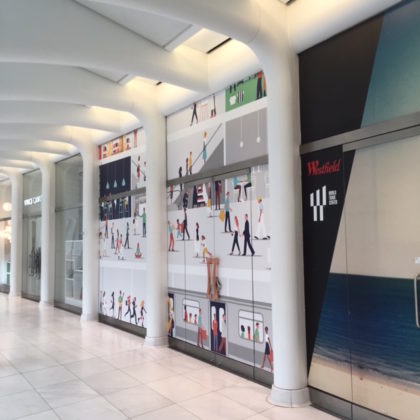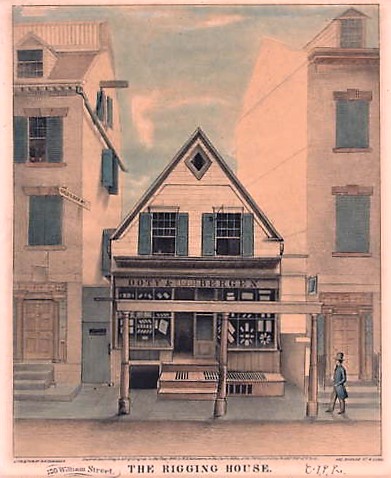Categories
Left column house ads
In the News: De Blasio Wants a Subway Tax on the Rich
August 7, 2017 Community News, Crime, History, Real Estate, Restaurant/Bar News, Shopping
 ••• The Wall Street Journal looks at the Westfield World Trade Center mall on the occasion of its first anniversary, noting its challenges: “While most of the space that can be occupied is open, a handful of retailers have closed their doors or delayed openings. In addition, Westfield still has at least a year wait for a portion of prime space that has been leased.” There isn’t much news in the piece, except for the explanation of why a prime corner space on the lower floor of the Oculus has been empty from the start: It “was to be taken by fashion retailer Michael Kors Holdings Ltd., which announced it would close 100 to 125 full-price stores over the next two years. Westfield said it is negotiating with Michael Kors to take back the space.” For my money, the main problem—after the death of retail in general—is the mix of stores, or lack thereof. I walk through the mall at least once a week, to get a coffee at Nobletree and buy produce at Eataly, and I’m rarely tempted by the other stores. What percentage is devoted to apparel, jewelry, and cosmetics? 95%? It’s too much. Mix it up!
••• The Wall Street Journal looks at the Westfield World Trade Center mall on the occasion of its first anniversary, noting its challenges: “While most of the space that can be occupied is open, a handful of retailers have closed their doors or delayed openings. In addition, Westfield still has at least a year wait for a portion of prime space that has been leased.” There isn’t much news in the piece, except for the explanation of why a prime corner space on the lower floor of the Oculus has been empty from the start: It “was to be taken by fashion retailer Michael Kors Holdings Ltd., which announced it would close 100 to 125 full-price stores over the next two years. Westfield said it is negotiating with Michael Kors to take back the space.” For my money, the main problem—after the death of retail in general—is the mix of stores, or lack thereof. I walk through the mall at least once a week, to get a coffee at Nobletree and buy produce at Eataly, and I’m rarely tempted by the other stores. What percentage is devoted to apparel, jewelry, and cosmetics? 95%? It’s too much. Mix it up!
••• A skateboarder snatched a cell phone, and more thefts in the Tribeca Trib‘s police blotter.
••• “Mayor Bill de Blasio plans to push for a tax on wealthy New Yorkers to pay for improvements needed to address the crisis engulfing New York City’s subway, city officials said on Sunday.” Why do I feel like that’s always his solution? Why not a tax on new real-estate developments? “The proposed new tax would raise about $700 million to $800 million a year, with more than $500 million going toward capital costs for subways and buses and about $250 million for the half-price MetroCard program, city officials said. It would increase the city’s highest income tax rate by about 0.5 percent, to 4.4 percent from about 3.9 percent, for married couples with incomes above $1 million and individuals who make more than $500,000. City officials estimate that the tax would be paid by about 32,000 New York City tax filers, or less than 1 percent of those who file their taxes in the city.” —New York Times
••• Speaking of tax ideas…. “As empty storefronts, even—or perhaps especially—in the most affluent neighborhoods in the city, have become such a distinguishing and unwelcome element of street life in recent years, questions have arisen about what sort of interventions might be made at the level of municipal government to stanch the bloodletting. One obvious measure of relief would be to reduce or restructure the obscure commercial rent tax, a burden imposed on business tenants whose rent exceeds $250,000 a year [….] The law affects business owners in Manhattan below 96th Street (though areas around the World Trade Center were exempted after Sept. 11), who must give the city 3.9 percent of what they pay in rent, with the bill rising as leases are renegotiated and fees to landlords go up. Often a tenant is paying this tax in addition to a real-estate tax already levied if, say, the tenant is occupying ground-floor space in a co-op building. […] Earlier this year, the City Council […] proposed raising the threshold at which the commercial rent tax comes into play to $500,000, from $250,000, an idea that had support on the Council as well as from state and federal officials. This would cost the city approximately $55 million. Although he has talked about the importance of small businesses to the city’s life and character, Mayor Bill de Blasio did not include the measure in his most recent budget.” Boldface mine. —New York Times
••• When Harry & Ida’s Luncheonette opens on Park Place this month, it’ll have “a build-your-own plate lunch model, as well as pastrami and smoked fish sandwiches [and] pre-made to-go options. New additions to the menu [include] watermelon caraway sauerkraut, smoked apricot ras el hanout chicken, turnip noodle kasha varnishkes with smoked rosemary oil, and braised broccoli stems with fermented black beans. Vegetables are more of a focus here as opposed to across town, and thus plates will start under $10, with the option to add smoked meats and fish. None of it will cost more than $13.50 though, even with the meaty additions.” The Meaty Additions: great name for a band. —Eater
••• “America’s first Methodists worshiped in the loft of a ship chandlers shop” at 120 William. “The ancient bldg survived until 1854.” (1846 etching by Henry R Robinson, from the collection of the Library of Congress.) —Daytonian in Manhattan
13 Comments
Comment:
Subscribe
Subscribe to the TC Newsletter














Taxing the “rich?” How original. He’s such a dodo.
Agreed. Can someone (anyone!) please run against him?
This is the third time he has proposed a tax on the “rich” both of the other times it never got through Albany and neither will this one. Just going through the motions to make it look like he is actually doing something.
Pay for the subway by raising livery tax. The rich will never notice, and they don’t take the subway anyway.
Re: empty storefronts
How about rent control/caps on commercial real estate?
(I do not believe “the market is always right”)
How about price and wage controls too? Should we abolish the minimum wage to protect retailers also? How about a maximum wage, then? (And then there are the inevitable unintended consequences- WW2 era wage controls directly led to the employer health insurance model we have today in this country.)
The epic change in retail has surprisingly little to do with rent increases. Just a small loss of the gross profit and sales to the internet can drive retailers out of business given their high percentage of fixed costs (rent, labor, utilities, etc.) that don’t drop with a drop in sales.
What de Blasio could really do for retailers and restaurants is reduce startup hurdles and ongoing red tape, whether with Dept of Buildings, Consumer Affairs, Health, Landmarks, etc.
Here’s one way to fix retail. Stop buying everything online! I promise, if you yourself (not a Postmate, not a Taskrabbit) walk into a store and purchase an item yourself you will get it much faster than an online purchase.
Think of all the people you are keeping employed by in-store shopping. Think of the carbon savings you are making by and recycling efficiencies you are making by purchasing in-store. Think of all the calories you will burn by walking to a store and carrying your items home yourself.
The only way we can keep TriBeCa’s independent retailers from going bankrupt is by purchasing items from their physical locations.
Can we talk about handicapped accessibility at the Oculus – or the lack thereof except for out of the way inconvenient and often not working elevators. Escalators that then become stairs are not easy to navigate.
What do you expect for a mere $4 billion?
The problem is many of the handicap accessible entrances/exits are still under construction. The absurd delays have caused these key components of the Oculus/Mall from opening, among the R/W trains and 1 train connection. That should be freaking done already too!
DeBlasio should push for the MTA to have transparent books so we can see where the money is really going before proposing a tax on NYC residents.
nypost.com/2017/07/27/whats-really-behind-the-mtas-money-woes/
“So what is the MTA spending its money on?
“The biggest culprit in skyrocketing costs is employee benefits. Consider that in 1985, retirement and health benefits for New York City Transit personnel cost $1.2 billion in today’s dollars. Today, they cost nearly $3.1 billion annually.
“At the MTA as a whole, in 2005, such costs constituted 23 percent of employee spending, costing $2.5 billion in today’s dollars. Today, they constitute 30 percent, costing $4.5 billion.
“This increase in benefit costs alone consumes all the additional revenue that the MTA takes in from the payroll tax the Legislature implemented in 2009. Should the Legislature enact a new tax, ever-increasing benefits likely will consume that, too.
“To be clear: This isn’t the unions’ fault. It’s MTA management — prodded by successive governors, including Cuomo — that has allowed costs to soar, by promising too much. The MTA owes nearly $19 billion in health care promises to future retirees — and has set just $300 million aside.
“Money that goes to employee benefits is money that can’t go to capital investment. So the MTA must borrow — another huge cost.
“In the early ’80s, the MTA had virtually no debt. Today, it owes nearly $40 billion — and Cuomo wants it to borrow another $10 billion over just five years.
“Debt payments will cost the MTA $2.6 billion this year. And the MTA’s legacy of debt from past capital investment programs consumes today’s revenues even as some of the infrastructure funded with that debt has expended its useful life. 1980s-era buses are long gone — but the MTA still owes money for them.”